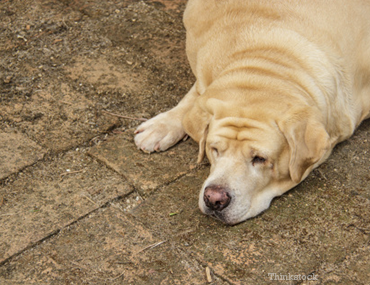
Dr. Jeff Werber discusses rotund pets, poor diets, and what you can do to get your pet back on the right track. For more from Dr. Werber, find him on Facebook or on his website at www.drjeff.com.
Just curious—how many of you have dogs or cats that help themselves to the cookie jar to grab those delicious chocolate chunk cookies or even their own yummy treats? How about the freezer to munch on that Haagen Dazs straight out of the container (as I do!!)?
Well, given how we often like to think that our pets mimic our personalities and behaviors, it should come as no surprise that obesity is the most common nutritional disorder affecting dogs and cats in the United States! In fact, it has been estimated that up to 50% of dogs and cats in this country are overweight or, worse yet, obese. Though many would like to blame this on some obscure metabolic disorder, the fact is that obesity in our pets is a result of the same simple practice that leads to our own obesity—eating too much and exercising too little! We are what we eat, and so too are our pets! The difference is we are in absolute control of what we stuff into our own mouths, our pets, however, don’t have that power—they have to rely on us for what is “stuffed” into their mouths!
Obesity is defined as an accumulation of excess body fat resulting in body weights over 15% of optimum. This condition can potentially impair the health, quality of life and life span of affected pets. There is an increased incidence of obesity with aging and after both spaying and neutering. This is likely associated with changes and reductions in metabolic rate and physical activity. Starting healthy choices young is especially important as 70% of obese puppies and kittens grow up to be obese dogs and cats!
Some breeds of dogs like Labrador Retrievers, Dachshunds, Miniature Schnauzers, Welsh Corgis, Cocker Spaniels, and Beagles seem to be genetically predisposed to excessive weight gain. Though not nearly as common as we would like to think, there are a few disease conditions in animals that may be associated with excess weight gain, such as hypothyroidism, which is an undersecretion of the thyroid gland; hyperadrenocorticism (also known as Cushing's Syndrome), an over secretion of the adrenal gland. Overweight dogs are often predisposed to a variety of conditions such as joint and locomotor problems, ruptured cruciate ligaments, dyspnea characterized by a shortness of breath, fatigue, cardiovascular disease, impaired reproductive efficiency, problems during whelping, increased incidence of diabetes mellitus, as well as an increased incidence of certain cancers.
Disease conditions in cats that may be associated with excessive body weight include respiratory and cardiovascular disease, joint and mobility problems, nonallergic skin conditions, impaired reproductive efficiency, and problems during queening.
Unfortunately, as with most of us, it is a lot easier to put the weight on than it is to take it off. Helping our pets lose weight is often quite a challenge. Pet owner compliance is essential to a successful weight reduction program. Prior to initiation of a weight control program, your overweight animal should have a thorough physical examination by your veterinarian. An ideal goal for weight loss is approximately 1% of current body weight per week, or approximately 3.5 to 4% per month. Cats should be monitored closely because rapid weight loss can lead to hepatic lipidosis, a potentially fatal fatty infiltration of the liver.
Although a dog or cat on a weight reduction program should receive a restricted amount of calories, they still need optimal amounts of other nutrients such as protein, vitamins and minerals. Weight loss may actually increase the need for these nutrients. An increased level of dietary fibers, may reduce the rate of digestion and absorption, and may assist in increasing the level of satiety—the perception of not being hungry—in the dieting pet. For an effective weight loss program, the basic goal is to reduce caloric intake and increase exercise. Ideally, with the help of your veterinarian, you want to determine your pet’s caloric intake at its optimal weight, and for reduction you want to feed only 60 to 65% of that number. Trust me—it's easier said than done!! If you need a little help, speak to your veterinarian about some weight management diets and supplements, and even a new weight loss medication to help your pets in their quest to shed those unwanted pounds.
So, to summarize, try to keep a closer watch on what you had your pet to nibble one, making healthy choices for yourself and your pet can lead to a happier and longer life. Remember the importance of exercise, starting slowly and easing into a daily routine. A happy and healthy pet is a lean pet!
If you have any questions or concerns, you should always visit or call your veterinarian – they are your best resource to ensure the health and well-being of your pets.
